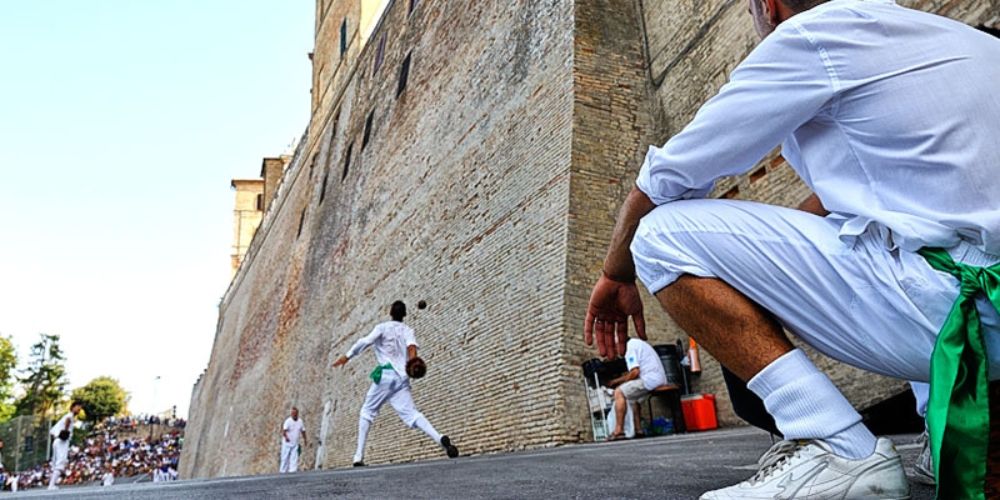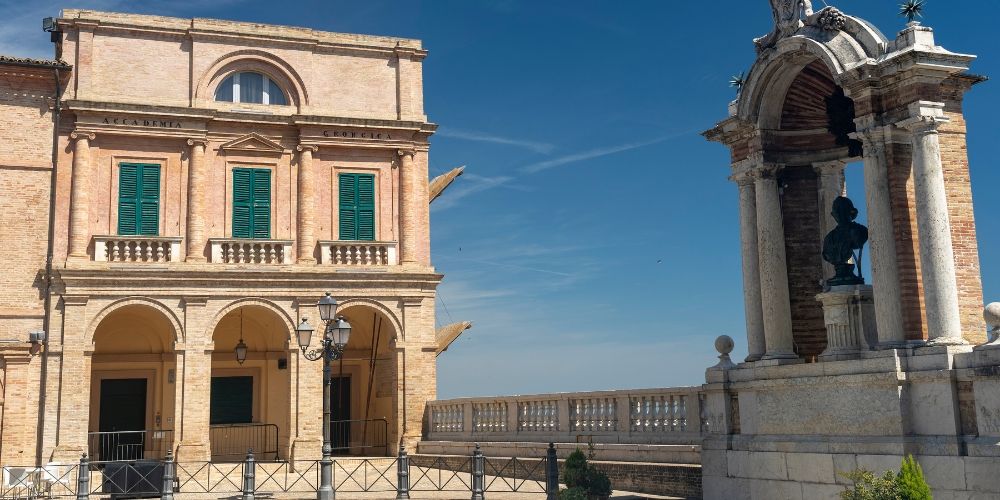A legendary sport practised with extravagantly shaped equipment in a place suspended in time.
No, it's not Quidditch, and we're not at Hogwarts, but you'll still feel a touch of magic as you visit Treia during the days of the Bracelet Challenge.
Here's what you need to know about one of Italy's most captivating and beloved historical reenactments.

Treia and its acclaimed Disfida del Bracciale

The acclaimed Disfida del Bracciale (Bracelet Challenge) is one of the main attractions to bring tourists and onlookers to the streets of Treia, a splendid fortified town in the province of Macerata.
Since 1979, this annual ball game tournament has been a fixture in the town's calendar, growing over the years into one of Italy's most famous historical reenactments.
La Disfida is set in 1821, the year Giacomo Leopardi composed the lyric 'A un vincitore nel pallone' inspired by the exploits of Carlo Didimi, a sports legend and undisputed city glory.
As per tradition, the Disfida is accompanied by intense celebrations that involve and unite the entire town. Treia's four districts—Borgo, Onglavina, Cassero, and Vallesacco—come alive with decorations, banners, and flags for the tournament duration.
Taverns stay open until late at night, workshops display the best typical handicrafts, painters and sculptors showcase their creations, and all kind of shows entertain fans every day.
If there’s a perfect time to visit Treia, it’s definitely during the Disfida.
When to see Treia's Disfida del Bracciale

The Bracelet Challenge has been held in Treia every year since 1979, always on the first Sunday of August. An absolutely thrilling event for the locals, this historic match marks the grand finale of ten days of celebrations raging throughout the historic centre.
Here is what it is all about. The teams from Treia's four contrade face off in the Sferisterio named after Carlo Didimi, each representing their unique colour: purple for Vallesacco, the district of artisans; yellow for Onglavina, known for the gypsies that used to live there; blue for Borgo, the peasant district; and green for Cassero, the quartiere of the nobles.
The stakes are high as the teams compete for the coveted trophy. The winner proudly keeps the award for a whole year before returning it at the opening ceremony of the next Disfida, during an impressive procession in 19th-century costumes. The following days buzz with events and performances. You will always find open taverns serving up local specialities and themed menus, while little charming shops offer the best regional products.
Obviously, the highlight is the final match, which is anticipated by a costume parade that pays homage to the golden age of the bracelet game and its 'messiah', Carlo Didimi. Even the players wear strictly white historical uniforms with only the colour of their waist sashes distinguishing the teams on the field.
La Disfida ends with a fireworks display and, of course, the celebration of the winning district.
The bracelet game

What is the bracelet game? What today may seem like an exotic amusement used to be the most popular and old team sport played in Italy until the first half of the last century.
Back in the day, the balloonists were seen as celebrities and often paid handsomely—much like footballers today.
To understand its origins, we must travel back to the opulent Renaissance courts, where the game was a favourite pastime among the nobility. The popularity of the bracelet game was such that Antonio Scaino da Salò codified the rules in his ‘Trattato del giuoco della palla’. Even today, regulations are not very different from those listed in the 1555 manual.
Let's start with the playing field. In addition to having a support wall on one side, each court must be the size of a rectangle whose length is between 80 and 100 metres, while the width ranges from 14 to a maximum of 20 metres.
Each team has three players: a ‘batter’, a ‘shoulder’ and a ‘third player’. There is also a fourth man, ‘il mandarino’, who is responsible for throwing the ball to the others. Similar to a tennis racket, the bracelet itself is a wooden tool that goes the whole way around the hand and is used to strike the ball.
In the 1900s, the bracelet game became the quintessential Italian national sport. However, its decline came in the following century, coinciding with the unstoppable rise of football, which soon monopolized the competitive passions of Italian fans.
Treia's Sferisterio

The bracelet game is played in a field called sferisterio. The one in Treia was inaugurated in 1818 with a match featuring Carlo Didimi, the local champion after whom the arena would later be named.
You can capture Treia's sferisterio from Piazza della Repubblica, looking out from the scenic balustrade by Andrea Vici. Actually, in addition to enjoying the splendid landscape of the Marche countryside, you can also see the symbolic site of the Bracelet Challenge from the town's main square.
To facilitate traffic in the area, Treia's ball court is now a road with a car park, traversed by cars and motorini for most of the year. However, it returns to its original function during the days of the tournament, when the place is once again transformed into a playing field where passion takes over and teams compete for glory.
The Bracelet Game Museum of Treia

Predictably, Treia features a small museum entirely dedicated to Pallone col Bracciale, the sport that has become an integral part of the history of this Marche town.
The exposition is located in the heart of the historic centre since 2018. The rich archive includes posters, photographs, vintage prints, trophies, balls, cups and, above all, bracelets, with antique examples dating back to the 19th century and more modern models.
We suggest checking out the Museo del Pallone col Bracciale for those interested in visiting Treia but cannot do so during the Disfida. It's the right place to understand the glory of a sport that has been nearly forgotten elsewhere. Also, it provides insight into what this game means for the town and how their histories are deeply intertwined.
Carlo Didimi, Treia's sport hero

A true example of courage, virtue, and energy for younger generations—this is how the famous poet Giacomo Leopardi portrays Carlo Didimi in his poem 'A un vincitore nel pallone'.
Leopardi, born and raised in Recanati, just over 20 kilometres from Treia, saw Didimi in action at the Macerata ball court in the autumn of 1821. In that strong and dynamic athlete, he immediately recognized the charm and greatness of the ancient heroes.
Born in Treia in 1798, Carlo Didimi is considered the greatest player in the history of the bracelet game, a living legend. His talent places him on the same level as a Diego Armando Maradona or a Lionel Messi of his sport.
A scion of a noble family, Carlo built his celebrity through outstanding victories on the playing field. One of his most celebrated moments came in 1824 when a record-setting hit at the Forlì Sferisterio cemented his place in the game's history.
Popularity and talent soon led to financial success, too. Like today's football stars, the legendary pallonista earned staggering sums for the time, especially compared to the average wages in the Papal States.
Nevertheless, Didimi wasn't just a phenomenal athlete. As a committed patriot and a Mazzinian activist, Treia's iconic figure took part in the 1831 revolutionary uprisings in Romagna and also fought against the papal troops in Umbria.
Didimi's legacy has left an unforgettable impact on his hometown. More than two centuries after his birth, Treia continues honouring his glorious citizen's memory, with the acclaimed Disfida del Bracciale as the emblem of this extraordinary heritage.
Treia, the town of the Bracelet Challenge

Treia, the town in the Macerata area that organises the Disfida, is considered the world capital of the Pallone col Bracciale game.
In addition to the events related to the town's iconic sport, the fortified borgo offers many cultural, gastronomic and natural attractions for entertaining tourists outside the days dedicated to the historic tournament.
The streets of Treia are like the pages of a book, a similarity that becomes evident when visiting the places beloved by cult writer Dolores Prato.
A special allure permeates every corner, scenic places like Piazza della Repubblica and small anonymous alleys alike. Exploring the area in more depth, one can also discover hidden jewels, such as the neoclassical villas designed by Valadier.
As you can see, Disfida del Bracciale is just one of the reasons you should visit Treia, a truly hidden treasure where Renaissance sports are still played, and beauty is everywhere.
About the author
Written on 20/11/2024


Lorena Calise
Forget football: in Treia, Marche, they play Pallone col Bracciale. Here’s everything you need to know about a legendary sport.